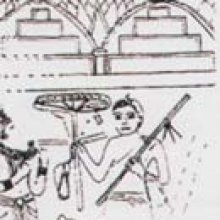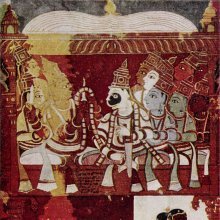Dead: 1 definition
Introduction:
Dead means something in Hinduism, Sanskrit. If you want to know the exact meaning, history, etymology or English translation of this term then check out the descriptions on this page. Add your comment or reference to a book if you want to contribute to this summary article.
Images (photo gallery)
In Hinduism
Yoga (school of philosophy)
Source: ORA: Amanaska (king of all yogas): A Critical Edition and Annotated Translation by Jason Birch(Being) Dead is denoted by the Sanskrit term Mṛta, according to the Amanaska Yoga treatise dealing with meditation, absorption, yogic powers and liberation.—Accordingly, as Īśvara says to Vāmadeva: “[...] [Now], I shall define the nature of that highest, mind-free absorption which arises for those devoted to constant practice. [...] And [that Yogin] is neither alive nor dead (mṛta), does not see nor close his eyes. He remains lifeless like a piece of wood and [thus] is said to be abiding in absorption. [...]”.

Yoga is originally considered a branch of Hindu philosophy (astika), but both ancient and modern Yoga combine the physical, mental and spiritual. Yoga teaches various physical techniques also known as āsanas (postures), used for various purposes (eg., meditation, contemplation, relaxation).
See also (Relevant definitions)
Starts with: Dead body, Dead finish, Dead nettle, Dead person, Dead sea apple, Dead sea fruit, Dead-and-awake, Deadly nightshade.
Full-text (+1551): Mrita, Jivanmrita, Preta, Mritasamjivana, Kunapa, Shava, Mritaka, Gataprana, Gatasu, Mudhagarbha, Mrityu, Yashahshesha, Shmashana, Mritasanjivani, Parashu, Vipanna, Nirharana, Vigata, Apagata, Alekhyashesha.
Relevant text
Search found 360 books and stories containing Dead; (plurals include: Deads). You can also click to the full overview containing English textual excerpts. Below are direct links for the most relevant articles:
Grass on the Grave < [January - March 1972]
Dead Greens < [January – March, 2005]
The Moon is Dead < [March-April 1935]
Manusmriti with the Commentary of Medhatithi (by Ganganatha Jha)
Verse 5.63 < [Section IX - Other forms of Impurity]
Verse 5.90 < [Section IX - Other forms of Impurity]
Verse 5.100 < [Section XI - Impurity in the case of persons beyond the pale of Sapiṇḍa relationship]
Kautilya Arthashastra (by R. Shamasastry)
Chapter 7 - Examination of Sudden Death < [Book 4 - Removal of Thorns]
Chapter 5 - Division of Inheritance < [Book 3 - Concerning Law]
Chapter 2 - Concerning Marriage < [Book 3 - Concerning Law]
Asvalayana-grihya-sutra (by Hermann Oldenberg)
Saying 11 - The Living Will Not Die
Saying 87 - Soul Should Be Independent Of Body
The Devi Bhagavata Purana (by Swami Vijñanananda)
Related products
(+68 more products available)











